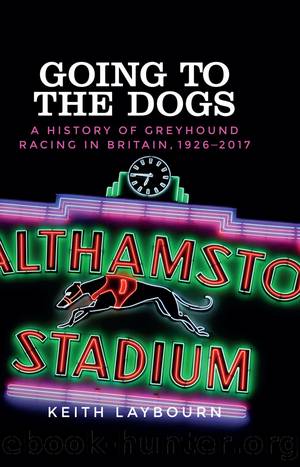Going to the Dogs by Laybourn Keith;

Author:Laybourn, Keith;
Language: eng
Format: epub
Publisher: Manchester University Press
4
Dog breeding, dog owning and dog training: dividing the classes
In twenty-first century Britain the internet is awash with adverts connected with the breeding and training of greyhounds. There is a Greyhound Breeder Information Centre, a Kennel Club connected with greyhounds, the Greyhound Stud Book and National Coursing Club, the Greyhound Trust, and numerous local organisations to place retired greyhounds. Indeed, the ownership of greyhounds for racing has recently become an immensely controversial issue largely because in many countries greyhounds are often destroyed after their racing careers unless saved by organisations finding them homes.1 In the nineteenth and early twentieth centuries there was much less concern about the racing of greyhounds and the cruelty of dog sports, although regulatory structures began to emerge. In 1858 the National Coursing Club was formed to regulate dogs, mainly greyhounds, chasing live lure such as foxes, deer and many other animals until the activity was confined to rabbits and rats in 2004. In 1882 the Greyhound Stud Book was set up to define the breed characteristics of a greyhound and the breed was then fixed and never changed.
All greyhounds, it is often claimed, are descended from the coursing greyhounds that raced in the prestigious Waterloo Cup on a course at Altar near Liverpool from 1836. It is thus clearly the case that well before greyhound racing, based upon the chasing of an artificial lure, began in the mid-1920s the breeding of greyhounds was already well established and clearly defined. Although some of the breeders ran large organisations the majority were raised, and even trained, by small owners at kennels in their back yards or on farms in Britain, and many were also bred in Ireland. The rapid growth of modern mechanical greyhound racing provided extra demand for the breeding of greyhounds on a scale coursing never quite generated, as greyhound racing developed quickly in urban centres and amongst working-class populations. This pattern lasted well into the 1960s and it was not until then that concerns about the cruelty to greyhounds began to emerge, amplifying the decline of greyhound racing both nationally and internationally.
Given the longevity of greyhound breeding, coursing and modern greyhound racing it is surprising, as Mark Clapson has concluded, that the least written about area of the greyhound racing – a much neglected topic in its own right – is the integrated and interconnected breeding, owning and training of greyhounds. Indeed, Clapson has hitherto provided just about the only, and then very brief, academic study of this area of the sport, suggesting that there were about 12,000 to 15,000 dogs being raced on seventy-three NGRS/NGRC tracks in 1949 and about 18,000 or 19,000 dogs owned by small owners racing largely on the flapping tracks. On his figures, drawn from the evidence to the Willink Commission, there were about 30,000 to 33,000 greyhounds racing on British greyhound tracks in 1949.2 He added that some large breeders provided dogs for the larger NGRS and non-NGRS tracks, that the dogs were often owned by the tracks
Download
This site does not store any files on its server. We only index and link to content provided by other sites. Please contact the content providers to delete copyright contents if any and email us, we'll remove relevant links or contents immediately.
American Kingpin by Nick Bilton(3510)
Future Crimes by Marc Goodman(3375)
The Meaning of the Library by unknow(2390)
Inside the Middle East by Avi Melamed(2233)
Why Nations Fail: The Origins of Power, Prosperity, and Poverty by Daron Acemoglu & James Robinson(2178)
On Tyranny by Timothy Snyder(2130)
Living Silence in Burma by Christina Fink(1985)
Putin's Labyrinth(1903)
The Mastermind by Evan Ratliff(1830)
The Smartest Kids in the World by Amanda Ripley(1686)
Think Like a Rocket Scientist by Ozan Varol(1679)
Law: A Very Short Introduction by Raymond Wacks(1636)
The Rule of Law by Bingham Tom(1594)
It's Our Turn to Eat by Michela Wrong(1593)
Leadership by Doris Kearns Goodwin(1564)
A Dirty War by Anna Politkovskaya(1543)
Philosophy of law a very short introduction by Raymond Wacks(1542)
Social Media Law in a Nutshell by Ryan Garcia & Thaddeus A Hoffmeister(1451)
Civil Procedure (Aspen Casebooks) by Stephen C. Yeazell(1440)
